Alfa Romeo Giulietta 2016 Owner's Manual
Manufacturer: ALFA ROMEO, Model Year: 2016, Model line: Giulietta, Model: Alfa Romeo Giulietta 2016Pages: 288, PDF Size: 7.34 MB
Page 141 of 288
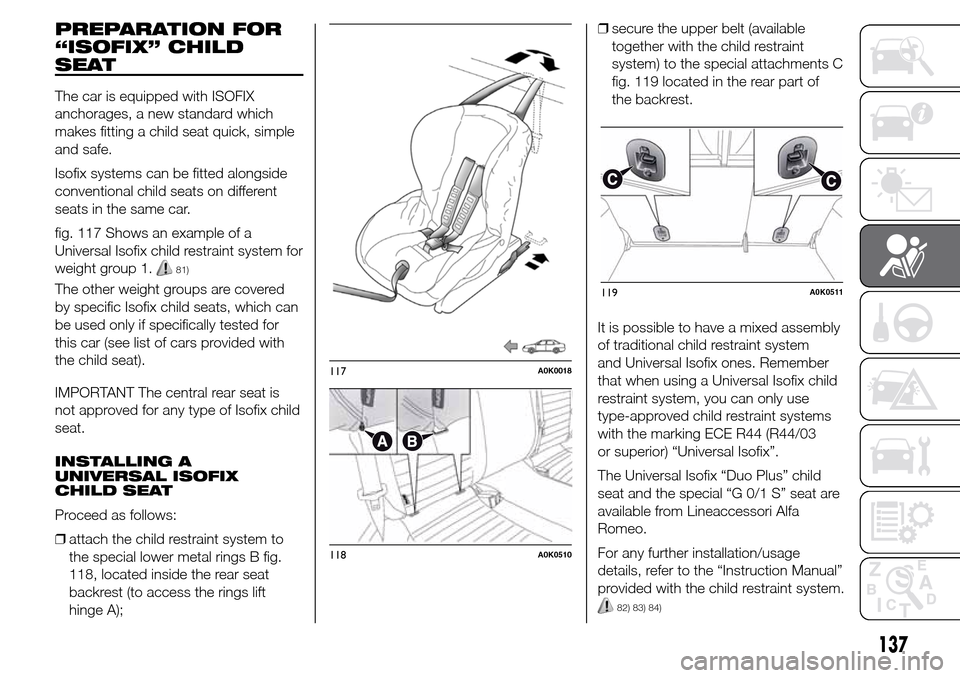
PREPARATION FOR
“ISOFIX” CHILD
SEAT
The car is equipped with ISOFIX
anchorages, a new standard which
makes fitting a child seat quick, simple
and safe.
Isofix systems can be fitted alongside
conventional child seats on different
seats in the same car.
fig. 117 Shows an example of a
Universal Isofix child restraint system for
weight group 1.
81)
The other weight groups are covered
by specific Isofix child seats, which can
be used only if specifically tested for
this car (see list of cars provided with
the child seat).
IMPORTANT The central rear seat is
not approved for any type of Isofix child
seat.
INSTALLING A
UNIVERSAL ISOFIX
CHILD SEAT
Proceed as follows:
❒attach the child restraint system to
the special lower metal rings B fig.
118, located inside the rear seat
backrest (to access the rings lift
hinge A);❒secure the upper belt (available
together with the child restraint
system) to the special attachments C
fig. 119 located in the rear part of
the backrest.
It is possible to have a mixed assembly
of traditional child restraint system
and Universal Isofix ones. Remember
that when using a Universal Isofix child
restraint system, you can only use
type-approved child restraint systems
with the marking ECE R44 (R44/03
or superior) “Universal Isofix”.
The Universal Isofix “Duo Plus” child
seat and the special “G 0/1 S” seat are
available from Lineaccessori Alfa
Romeo.
For any further installation/usage
details, refer to the “Instruction Manual”
provided with the child restraint system.
82) 83) 84)
117A0K0018
118A0K0510
119A0K0511
137
Page 142 of 288
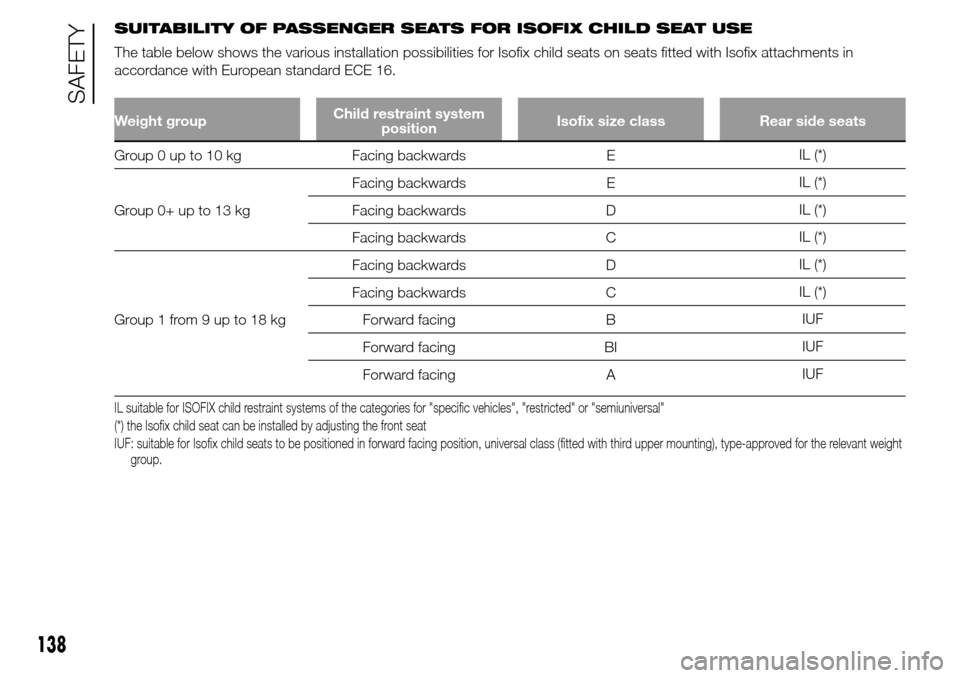
SUITABILITY OF PASSENGER SEATS FOR ISOFIX CHILD SEAT USE
The table below shows the various installation possibilities for Isofix child seats on seats fitted with Isofix attachments in
accordance with European standard ECE 16.
Weight groupChild restraint system
positionIsofix size class Rear side seats
Group 0 up to 10 kg Facing backwards EIL (*)
Group 0+ up to 13 kgFacing backwards EIL (*)
Facing backwards DIL (*)
Facing backwards CIL (*)
Group1from9upto18kgFacing backwards DIL (*)
Facing backwards CIL (*)
Forward facing BIUF
Forward facing BIIUF
Forward facing AIUF
IL suitable for ISOFIX child restraint systems of the categories for "specific vehicles", "restricted" or "semiuniversal"
(*) the Isofix child seat can be installed by adjusting the front seat
IUF: suitable for Isofix child seats to be positioned in forward facing position, universal class (fitted with third upper mounting), type-approvedfor the relevant weight
group.
138
SAFETY
Page 143 of 288
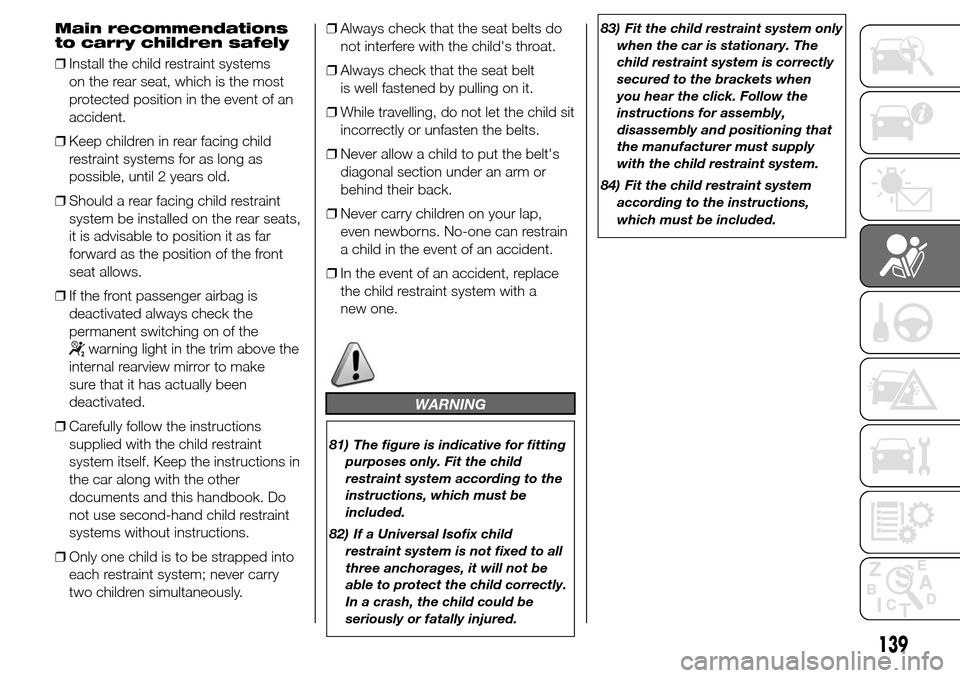
Main recommendations
to carry children safely
❒Install the child restraint systems
on the rear seat, which is the most
protected position in the event of an
accident.
❒Keep children in rear facing child
restraint systems for as long as
possible, until 2 years old.
❒Should a rear facing child restraint
system be installed on the rear seats,
it is advisable to position it as far
forward as the position of the front
seat allows.
❒If the front passenger airbag is
deactivated always check the
permanent switching on of the
warning light in the trim above the
internal rearview mirror to make
sure that it has actually been
deactivated.
❒Carefully follow the instructions
supplied with the child restraint
system itself. Keep the instructions in
the car along with the other
documents and this handbook. Do
not use second-hand child restraint
systems without instructions.
❒Only one child is to be strapped into
each restraint system; never carry
two children simultaneously.❒Always check that the seat belts do
not interfere with the child's throat.
❒Always check that the seat belt
is well fastened by pulling on it.
❒While travelling, do not let the child sit
incorrectly or unfasten the belts.
❒Never allow a child to put the belt's
diagonal section under an arm or
behind their back.
❒Never carry children on your lap,
even newborns. No-one can restrain
a child in the event of an accident.
❒In the event of an accident, replace
the child restraint system with a
new one.
WARNING
81) The figure is indicative for fitting
purposes only. Fit the child
restraint system according to the
instructions, which must be
included.
82) If a Universal Isofix child
restraint system is not fixed to all
three anchorages, it will not be
able to protect the child correctly.
In a crash, the child could be
seriously or fatally injured.83) Fit the child restraint system only
when the car is stationary. The
child restraint system is correctly
secured to the brackets when
you hear the click. Follow the
instructions for assembly,
disassembly and positioning that
the manufacturer must supply
with the child restraint system.
84) Fit the child restraint system
according to the instructions,
which must be included.
139
Page 144 of 288
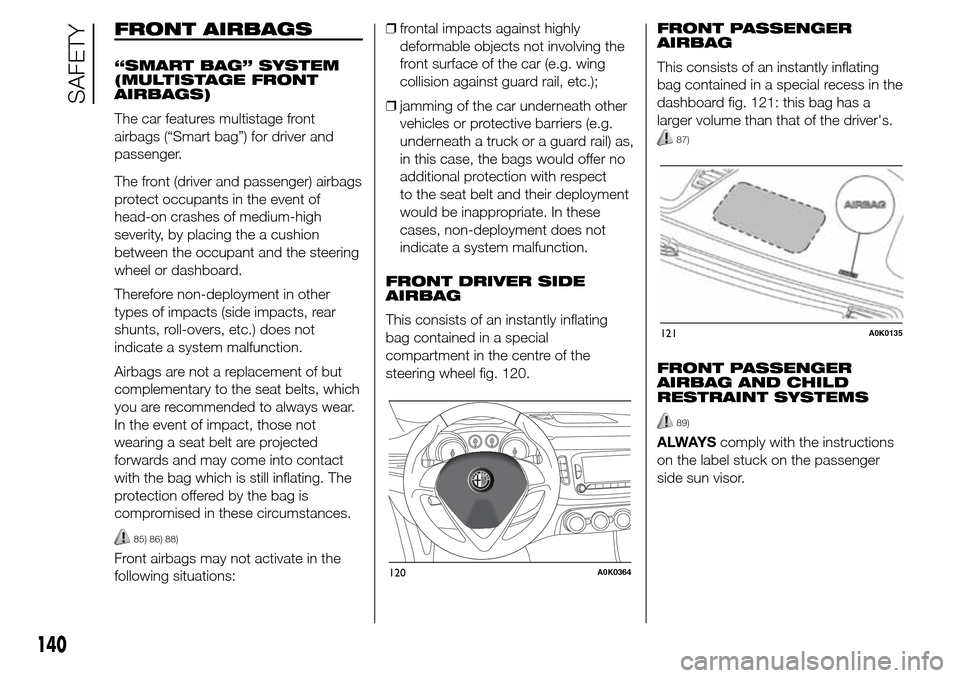
FRONT AIRBAGS
“SMART BAG” SYSTEM
(MULTISTAGE FRONT
AIRBAGS)
The car features multistage front
airbags (“Smart bag”) for driver and
passenger.
The front (driver and passenger) airbags
protect occupants in the event of
head-on crashes of medium-high
severity, by placing the a cushion
between the occupant and the steering
wheel or dashboard.
Therefore non-deployment in other
types of impacts (side impacts, rear
shunts, roll-overs, etc.) does not
indicate a system malfunction.
Airbags are not a replacement of but
complementary to the seat belts, which
you are recommended to always wear.
In the event of impact, those not
wearing a seat belt are projected
forwards and may come into contact
with the bag which is still inflating. The
protection offered by the bag is
compromised in these circumstances.
85) 86) 88)
Front airbags may not activate in the
following situations:❒frontal impacts against highly
deformable objects not involving the
front surface of the car (e.g. wing
collision against guard rail, etc.);
❒jamming of the car underneath other
vehicles or protective barriers (e.g.
underneath a truck or a guard rail) as,
in this case, the bags would offer no
additional protection with respect
to the seat belt and their deployment
would be inappropriate. In these
cases, non-deployment does not
indicate a system malfunction.
FRONT DRIVER SIDE
AIRBAG
This consists of an instantly inflating
bag contained in a special
compartment in the centre of the
steering wheel fig. 120.FRONT PASSENGER
AIRBAG
This consists of an instantly inflating
bag contained in a special recess in the
dashboard fig. 121: this bag has a
larger volume than that of the driver's.
87)
FRONT PASSENGER
AIRBAG AND CHILD
RESTRAINT SYSTEMS
89)
ALWAYScomply with the instructions
on the label stuck on the passenger
side sun visor.
120A0K0364
121A0K0135
140
SAFETY
Page 145 of 288
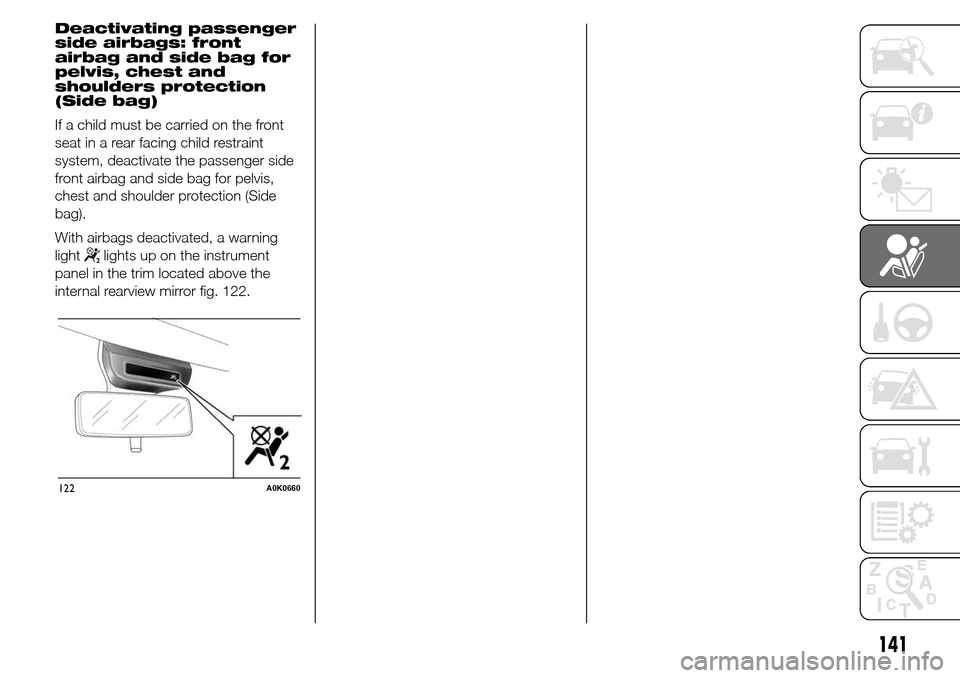
Deactivating passenger
side airbags: front
airbag and side bag for
pelvis, chest and
shoulders protection
(Side bag)
If a child must be carried on the front
seat in a rear facing child restraint
system, deactivate the passenger side
front airbag and side bag for pelvis,
chest and shoulder protection (Side
bag).
With airbags deactivated, a warning
light
lights up on the instrument
panel in the trim located above the
internal rearview mirror fig. 122.
122A0K0660
141
Page 146 of 288
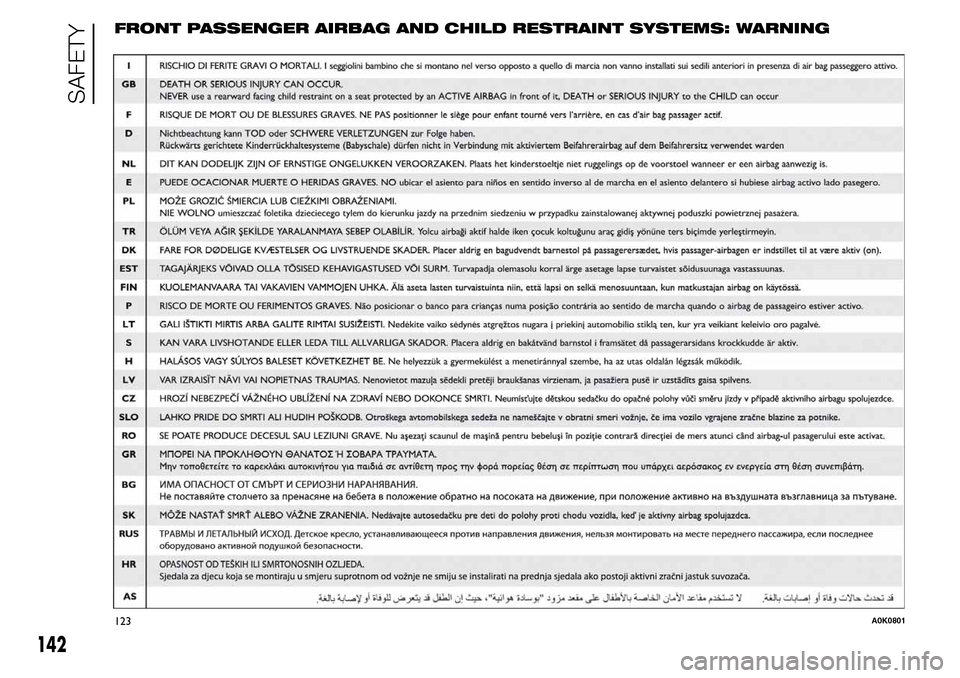
FRONT PASSENGER AIRBAG AND CHILD RESTRAINT SYSTEMS: WARNING
123A0K0801
142
SAFETY
Page 147 of 288
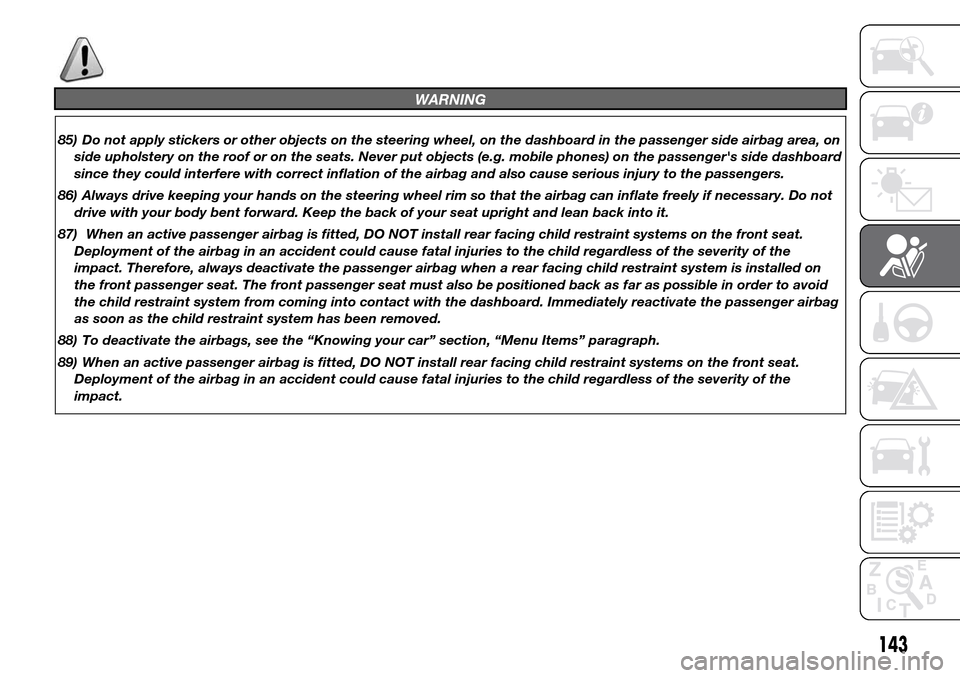
WARNING
85) Do not apply stickers or other objects on the steering wheel, on the dashboard in the passenger side airbag area, on
side upholstery on the roof or on the seats. Never put objects (e.g. mobile phones) on the passenger's side dashboard
since they could interfere with correct inflation of the airbag and also cause serious injury to the passengers.
86) Always drive keeping your hands on the steering wheel rim so that the airbag can inflate freely if necessary. Do not
drive with your body bent forward. Keep the back of your seat upright and lean back into it.
87) When an active passenger airbag is fitted, DO NOT install rear facing child restraint systems on the front seat.
Deployment of the airbag in an accident could cause fatal injuries to the child regardless of the severity of the
impact. Therefore, always deactivate the passenger airbag when a rear facing child restraint system is installed on
the front passenger seat. The front passenger seat must also be positioned back as far as possible in order to avoid
the child restraint system from coming into contact with the dashboard. Immediately reactivate the passenger airbag
as soon as the child restraint system has been removed.
88) To deactivate the airbags, see the “Knowing your car” section, “Menu Items” paragraph.
89) When an active passenger airbag is fitted, DO NOT install rear facing child restraint systems on the front seat.
Deployment of the airbag in an accident could cause fatal injuries to the child regardless of the severity of the
impact.
143
Page 148 of 288
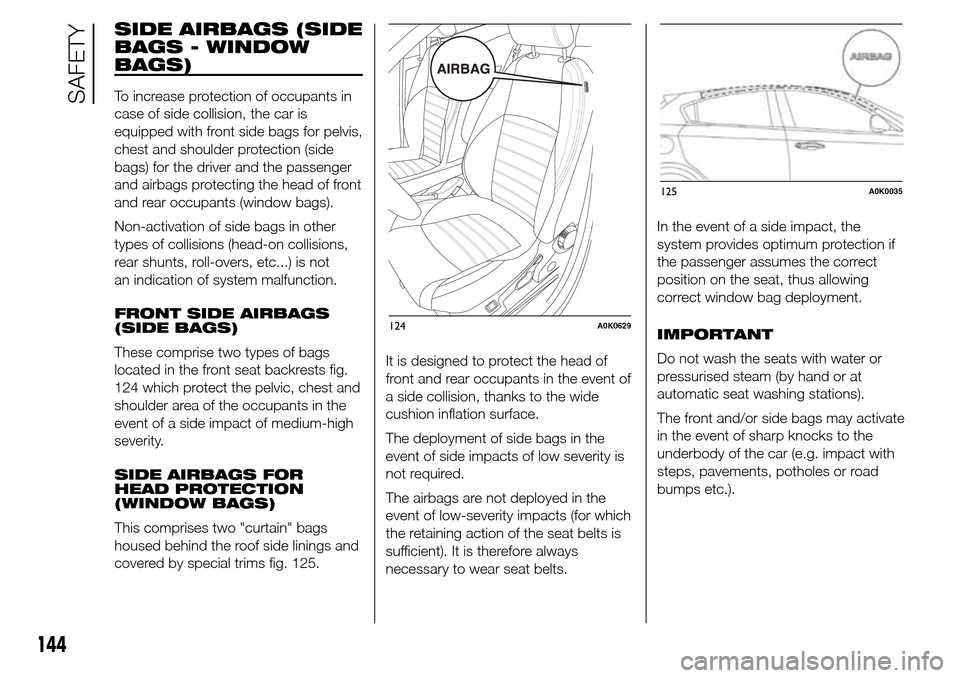
SIDE AIRBAGS (SIDE
BAGS - WINDOW
BAGS)
To increase protection of occupants in
case of side collision, the car is
equipped with front side bags for pelvis,
chest and shoulder protection (side
bags) for the driver and the passenger
and airbags protecting the head of front
and rear occupants (window bags).
Non-activation of side bags in other
types of collisions (head-on collisions,
rear shunts, roll-overs, etc...) is not
an indication of system malfunction.
FRONT SIDE AIRBAGS
(SIDE BAGS)
These comprise two types of bags
located in the front seat backrests fig.
124 which protect the pelvic, chest and
shoulder area of the occupants in the
event of a side impact of medium-high
severity.
SIDE AIRBAGS FOR
HEAD PROTECTION
(WINDOW BAGS)
This comprises two "curtain" bags
housed behind the roof side linings and
covered by special trims fig. 125.It is designed to protect the head of
front and rear occupants in the event of
a side collision, thanks to the wide
cushion inflation surface.
The deployment of side bags in the
event of side impacts of low severity is
not required.
The airbags are not deployed in the
event of low-severity impacts (for which
the retaining action of the seat belts is
sufficient). It is therefore always
necessary to wear seat belts.In the event of a side impact, the
system provides optimum protection if
the passenger assumes the correct
position on the seat, thus allowing
correct window bag deployment.
IMPORTANT
Do not wash the seats with water or
pressurised steam (by hand or at
automatic seat washing stations).
The front and/or side bags may activate
in the event of sharp knocks to the
underbody of the car (e.g. impact with
steps, pavements, potholes or road
bumps etc.).
124A0K0629
125A0K0035
144
SAFETY
Page 149 of 288
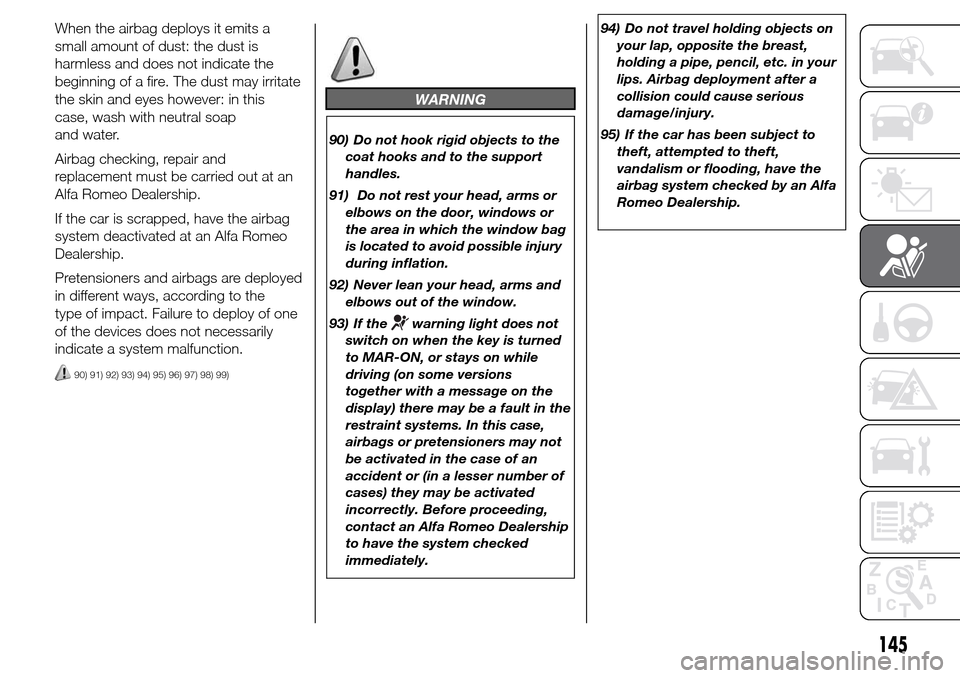
When the airbag deploys it emits a
small amount of dust: the dust is
harmless and does not indicate the
beginning of a fire. The dust may irritate
the skin and eyes however: in this
case, wash with neutral soap
and water.
Airbag checking, repair and
replacement must be carried out at an
Alfa Romeo Dealership.
If the car is scrapped, have the airbag
system deactivated at an Alfa Romeo
Dealership.
Pretensioners and airbags are deployed
in different ways, according to the
type of impact. Failure to deploy of one
of the devices does not necessarily
indicate a system malfunction.
90) 91) 92) 93) 94) 95) 96) 97) 98) 99)
WARNING
90) Do not hook rigid objects to the
coat hooks and to the support
handles.
91) Do not rest your head, arms or
elbows on the door, windows or
the area in which the window bag
is located to avoid possible injury
during inflation.
92) Never lean your head, arms and
elbows out of the window.
93) If the
warning light does not
switch on when the key is turned
to MAR-ON, or stays on while
driving (on some versions
together with a message on the
display) there may be a fault in the
restraint systems. In this case,
airbags or pretensioners may not
be activated in the case of an
accident or (in a lesser number of
cases) they may be activated
incorrectly. Before proceeding,
contact an Alfa Romeo Dealership
to have the system checked
immediately.94) Do not travel holding objects on
your lap, opposite the breast,
holding a pipe, pencil, etc. in your
lips. Airbag deployment after a
collision could cause serious
damage/injury.
95) If the car has been subject to
theft, attempted to theft,
vandalism or flooding, have the
airbag system checked by an Alfa
Romeo Dealership.
145
Page 150 of 288
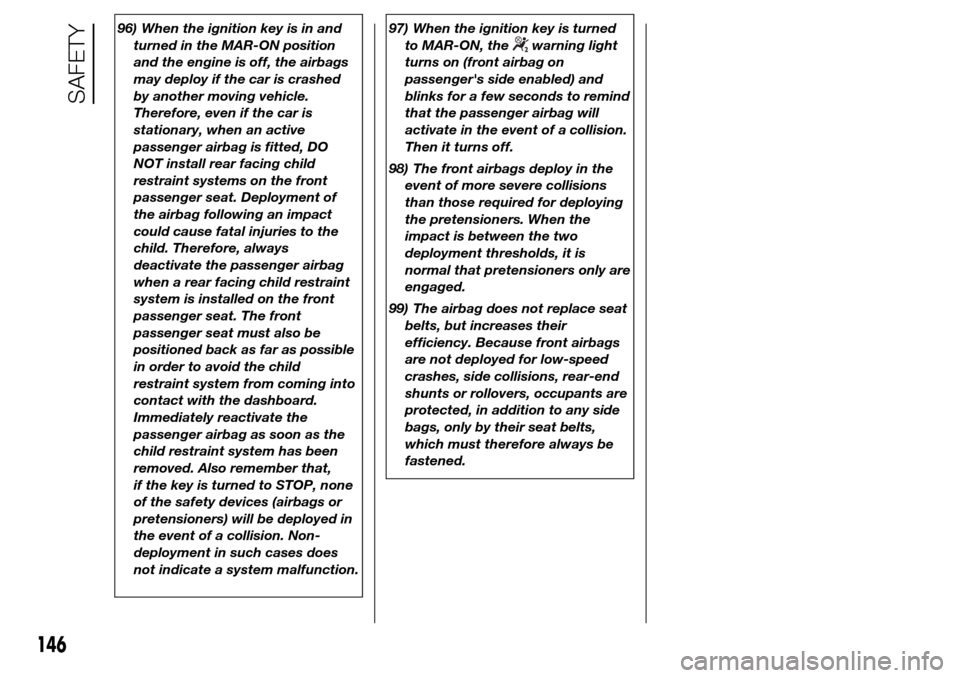
96) When the ignition key is in and
turned in the MAR-ON position
and the engine is off, the airbags
may deploy if the car is crashed
by another moving vehicle.
Therefore, even if the car is
stationary, when an active
passenger airbag is fitted, DO
NOT install rear facing child
restraint systems on the front
passenger seat. Deployment of
the airbag following an impact
could cause fatal injuries to the
child. Therefore, always
deactivate the passenger airbag
when a rear facing child restraint
system is installed on the front
passenger seat. The front
passenger seat must also be
positioned back as far as possible
in order to avoid the child
restraint system from coming into
contact with the dashboard.
Immediately reactivate the
passenger airbag as soon as the
child restraint system has been
removed. Also remember that,
if the key is turned to STOP, none
of the safety devices (airbags or
pretensioners) will be deployed in
the event of a collision. Non-
deployment in such cases does
not indicate a system malfunction.97) When the ignition key is turned
to MAR-ON, the
warning light
turns on (front airbag on
passenger's side enabled) and
blinks for a few seconds to remind
that the passenger airbag will
activate in the event of a collision.
Then it turns off.
98) The front airbags deploy in the
event of more severe collisions
than those required for deploying
the pretensioners. When the
impact is between the two
deployment thresholds, it is
normal that pretensioners only are
engaged.
99) The airbag does not replace seat
belts, but increases their
efficiency. Because front airbags
are not deployed for low-speed
crashes, side collisions, rear-end
shunts or rollovers, occupants are
protected, in addition to any side
bags, only by their seat belts,
which must therefore always be
fastened.
146
SAFETY